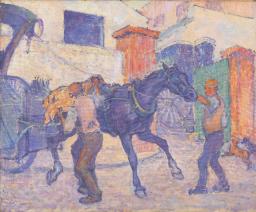Author unknown, ‘The Camden Town Group’
The Bazaar, The Exchange and Mart, 30 June 1911, p.1319.
The Camden Town Group.
The Sickert School is in Camden Town, and perhaps hence is the connection which formed the group of sixteen, Mr. Walter Sickert being one of them, holding their first exhibition at the Carfax Gallery. Mr. Spencer F. Gore is its president. Ideality, poetry, tenderness, are not for any of these artists. They are concerned with actuality, and with paint, and with light, and, to some extent, with design. Colour is sometimes strident, as in Mr. Gore’s “Mornington Crescent,” with the Camden Theatre and very vivid red Tube Station walls heightened by the crescent’s acrid-green vegetation. Truly impressionistic and clever are the cab-yard scenes by Mr. R. P. Bevan, who commanded attention by them at the New English Art Club a year or so since. Lucien Pissarro is no longer spotty in touch, and altogether, though “advanced,” he is not insensible to beauty, as beauty is commonly understood. This is particularly evidenced in “Buttercups, Colchester,” the town a grey and mundane background to the golden glory of foreground field. Mr. Pissarro also has a notable painting (surely we have seen it before?) in “Well Farm Bridge, Acton.” To our mind, art is debased when its practitioners descend to such loathsome themes as “The Camden Town Murder.” It should be possible to find healthier and more optically attractive motives for dealing with tones at dawning day. The exhibition is interesting to followers of movements in modern art, but it is not fascinating, and we are left wondering whether this is art which will survive, or even whether it will greatly mature. Clever in its way is the architecturally-severe face of “The Architect,” drawn with pen and ink by Mr. Wyndham Lewis. Unwonted sentiment is revealed by Mr. Lightfoot in “Mother and Child,” so much of all-in-all is suggested between the two. Mr. H. Lamb has firm drawing in the stolid “Brittany Peasant Boy,” painted in [a] rather flat way. Flat tint to pen outline is used by Mr. Walter Bayes in “Classical Landscape,” and of Mr. Bayes’ artistry there is no doubt. Mr. Drummond conveys the feeling of bustle at “Paddington Station,” and is strong in an “Interior.” An oil-painting that has almost the transparency of watercolour, and is an exercise in whites, is of laundry hung out, “The Snow Scene,” by Mr. H. Gilman, but his “Portrait” is of kaleidoscopic glitter that would be disturbing to live with. “The Window Seat,” giving view of waste common with a gipsy van, by Mr. W. Ratcliffe, is good. The remaining members are Mr. Ginner, Mr. John, Mr. Manson, and Mr. J.D. Turner.
How to cite
Author unknown, ‘The Camden Town Group’, in The Bazaar, The Exchange and Mart, 30 June 1911, p.1319, in Helena Bonett, Ysanne Holt, Jennifer Mundy (eds.), The Camden Town Group in Context, Tate Research Publication, May 2012, https://www

